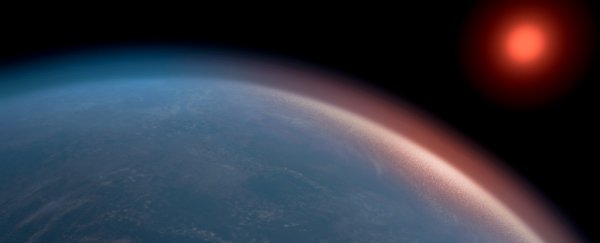When it was very young, the planet Earth looked rather different from the one we know and love today. For one, it had supercontinents - when the landmasses we currently live on were arranged in various configurations as they were pushed around by tectonic movements.
But there may have been a period when there were very few or no landmasses at all, and Earth was a soggy waterworld, according to new research.
Evidence found in the geologic record suggests that, around 3.2 billion years ago, our currently 4.5-billion-year-old homeworld was covered by a global ocean.
If confirmed, such a finding could help to resolve questions around how life emerged roughly 3.5 billion years ago; in particular, whether it got its start in freshwater ponds on landmasses, or in salty seas. If there were no bodies of dry land to host freshwater, the question is rendered moot.
"The history of life on Earth tracks available niches," explained geobiologist Boswell Wing of the University of Colorado Boulder. "If you've got a waterworld, a world covered by ocean, then dry niches are just not going to be available."
The research team was actually trying to take early Earth's temperature, a question that has long proven difficult to resolve. It's unclear whether the planet was much warmer or cooler (or around the same temperatures as today) when life was emerging.
But the ratio of two oxygen isotopes - naturally occurring variations of the element - can be linked to the temperature of ancient oceans because of their different molecular weights. Lower-temperature water contains a higher amount of oxygen-16 compared to oxygen-18, and vice versa.
There isn't a great deal of 3.2 billion-year-old seawater still around to analyse. But there are rocks of that age that used to be on the floor of those ancient oceans, such as the Panorama District in the Pilbara region in Western Australia. Those rocks retain the chemical history of the oceans - including an exquisitely preserved system of hydrothermal vents.
But even after the researchers had reconstructed a temperature profile of the region 3.2 billion years ago, there was just a little more oxygen-18 than they would have expected - 3.3 percent. That's about 4 percent more compared to the amount in today's relatively ice-free ocean, and much higher than previous estimates.
A 2012 paper similarly found slightly higher-than-expected enrichment of oxygen-18 in the oceans 3.8 billion years ago - 0.8 to 3.8 percent.
These are only small differences, but they're also very sensitive to landmass. Soil on large areas of land - continent-sized ones - disproportionately slurps up heavier isotopes like oxygen-18 from the water.
According to modelling, researchers have now found that the ratios in their rock samples could be attributed to a lack of continents. That doesn't mean the planet was necessarily entirely wet, like Enceladus or Europa would be if they were closer to the Sun; but it could have been much, much soggier than Earth is right now.
"There's nothing in what we've done that says you can't have teeny, micro-continents sticking out of the oceans," Wing said. "We just don't think that there were global-scale formation of continental soils like we have today."
Of course, that then raises the question: when exactly did the continents emerge, pushed out of the ocean by tectonic plates smushing together? That's the next step of the research. The team plans to investigate younger rock formations to try to piece together that timeline.
The research has been published in Nature Geoscience.
